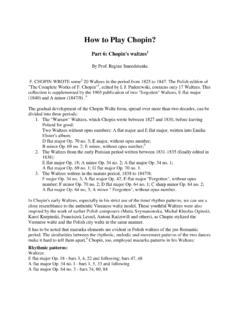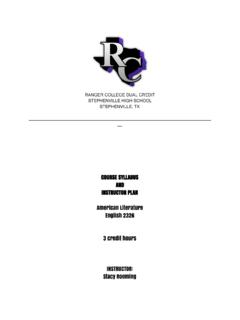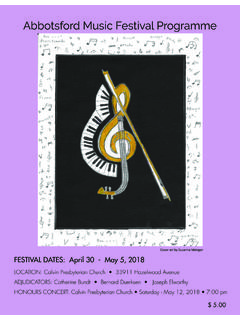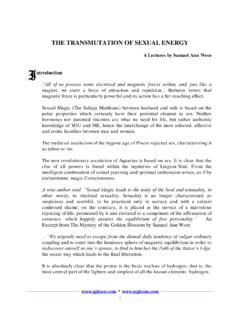Transcription of NEA exemplar response - filestore.aqa.org.uk
1 NEA: Independent critical study: Texts across time - exemplar response This resource gives an exemplar student response to a non-exam assessment task, with an accompanying moderator commentary illustrating why the response has been placed within a particular band of the assessment criteria. This resource should be used in conjunction with the accompanying document 'Guidance on non-exam assessment - Independent critical study: Texts across time'. exemplar student response Compare and contrast the ways in which Elizabeth Gaskell and Henrik Ibsen present the relationships between Margaret Hale and John Thornton in North and South (1854-55) and Nora and Torvald Helmer in A Doll s House (1879).
2 Examine the view that, in both texts, the personal is political . Both North and South (1854-55) and A Doll s House (1879) present women living in patriarchal eras. In comparing Gaskell s novel about a woman who saves her husband-to-be from bankruptcy and ruin and Ibsen s well-made play about a woman who once saved her husband s life but abandons him after he betrays her, I will look at how various readers and audiences might interpret them and how far they can be seen as having a wider political relevance from a feminist point of view. Both Gaskell s Condition of England novel and Ibsen s Woman Question melodrama are set against a contemporary backdrop of massive social change.
3 One interesting similarity between the texts is the way that the heroines relationships with their fathers affect their marriages which is what might be expected in a patriarchal society. In North and South Gaskell presents this as very positive; Mr Hale admires John Thornton and tells Margaret how he absolutely lived upon water-porridge for years to support his mother and sister after his father speculated wildly, failed, and then killed himself (p129). At this early stage in the novel, however, while Margaret admits this really is fine , she still argues it is a pity such a nature should be tainted by his position as a Milton manufacturer (p129). Much later, when she gives Thornton her late father s books as a peace offering, the gift symbolises that the female southerner now understands the male northerner and therefore I interpret Gaskell s positive link here as being both personal and political.
4 Towards the end of A Doll s House, however, Nora Helmer sees a negative link between her husband Torvald and her dead father when she has an epiphany about her past and present. When Nora realises I was simply transferred from Papa s hands to yours .. You and Papa have committed a great sin against me. It is your fault that I have made nothing of my life (p66), it is a key moment in the play. Although Torvald accuses Nora of being like her father in having no religion, no morality, and no sense of duty (p62) Nora turns this around and says that actually it is Torvald who resembles him. Stephanie Forward interprets this moment of anagnorisis from a feminist perspective, as the moment Nora finally comes to see herself as an object moulded by her father and then by her husband (1) and I agree with this; I think Nora s realisation that she has lived in a home that has been nothing but a playroom , treated as a doll wife, just as at home I was Papa s doll child is both personally and politically the most important moment in the play (p67).
5 But while Nora seems to reach an awareness of the power of men at the climax of the drama, walking out of her home to the famous stage sound effect of the slamming door, previously she showed a rather stereotypical na ve innocence about this which is very similar to Margaret s behaviour when she fails to realise the implications of her behaviour during the riot in North and South. To a modern audience, Nora s comments about Torvald seem more like a crush or hero worship; by the time she insists to Kristine Linde that Torvald will want to take all the responsibility, all the blame (p46) if he finds out about Krogstad in the middle of Act Two, from what we ve already seen of him, this already seems very unlikely.
6 Yet I think Gaskell presents Margaret s behaviour as even more deluded in the riot scene; She only thought how she could save him. She threw her arms around him; she made her body into a shield from the fierce people beyond .. Then he unfolded his arms, and held her encircled in one for an instant (pp234-235). Such a public display of affection in the Victorian era would have risked Margaret s reputation, so she puts the safety of the man she loves over certain scandal. Gaskell presents this act as instinctive and spontaneous, led by subconscious desire; when Thornton honourably proposes afterwards, Margaret denies her love for him, claiming that 'It was only a natural instinct; any woman would have done just the same (p252).
7 But as she speaks, her body language reveals another story; In spite of herself in defiance of her anger the thick blushes came all over her face, and burnt into her very eyes (p252). From a twenty-first century reader s point of view it looks like the narrator knows more than Margaret does, and Gaskell uses blushing to symbolise the heroine feeling forced to act like a perfect Victorian lady and deny her true feelings. This scene makes the personal context very political in terms of the wider context of the subjugation of women in the nineteenth century. In contrast to Margaret, however, underneath her public praise of her husband s honesty, talent and bravery, Nora Helmer understands him very well after eight years of marriage and has secretly protected him from knowing she saved his life.
8 How painful and humiliating it would be for Torvald, with his manly independence, to know that he owed me anything! It would upset our mutual relations altogether; our beautiful happy home would no longer be what it is now (p12). In spite of her surface lack of status as a middle-class woman, however, throughout A Doll s House Ibsen shows Nora running rings around Torvald, even using his patriarchal attitude to flatter him into giving Kristina Linde a job by saying she took a long journey in order to see you .. she is frightfully anxious to work under some clever man, so as to perfect herself (p17). Furthermore, in terms of structure, Ibsen allows the audience to see Nora partaking in low-level deception from the very beginning of the play, secretly buying macaroons when Torvald has specifically banned them.
9 The stage directions describe her taking a packet .. from her pocket and eating one or two while going cautiously to her husband s door (p1). The fact Torvald has forbidden them as they will ruin [her] teeth shows how the doll-wife role she has in their marriage follows directly on from her life with her father, as Torvald also treats her like a child. Perhaps Ibsen was challenging married couples in his original audience to compare their own relationship to the Helmers , to start a wider debate about the role of women in society as a whole. The treatment of women as simply men s possessions is a dominant theme in A Doll s House and Ibsen dramatises Nora s increasing fears for the survival of her marriage if Torvald ever finds out the truth about her ability to manage perfectly well without him.
10 In North and South, I find it very interesting that the context of production itself can be seen as both personal and political from a feminist point of view. Gaskell herself wanted to call the novel Margaret Hale, to stress the importance of the heroine, but she was overruled by Charles Dickens, the editor of the weekly magazine Household Words in which it was first published from September 1854 to January 1855. Dickens argued that North and South encompasses more and emphasises the opposition between people who are forced by circumstances to meet face to face , potentially seeing it as a sequel to his own industrial novel Hard Times, which preceded it in the magazine (2).


















